Avadex is the starter herbicide for a black-grass programme
5th September 2016
Crop Production Specialist for Frontier Agriculture Ltd, Dr Paul Fogg, says that herbicide programmes in trials this year generally worked well, but he acknowledged that the mild and wet winter had

Dr Paul Fogg.
Crop Production Specialist for Frontier Agriculture Ltd, Dr Paul Fogg, says that herbicide programmes in trials this year generally worked well, but he acknowledged that the mild and wet winter had provided ideal conditions for continued growth and tillering and ultimately final head count scores were disappointing.
“Avadex had a particularly good year and on average gave up to 30% contribution to black-grass control,” says Paul.
Paul considers Avadex Granules to now be a foundation product in the black-grass herbicide programme, whether it is applied by the farmers own applicator or by a contractor. “If the latter, Paul says that farmers must plan ahead and book the contractor now. Don’t leave it to chance. Now that Avadex has to be applied pre-emergence, you need to sort out how you are going to apply it and book the contractor,” he says.
He says that in his view a strong, robust programme would start with Avadex 15G (triallate) at 15kg/ha, followed by flufenacet +/- at least two other active substances. Rates of flufenacet should be 240g/ha as a minimum but in bad black-grass situations 360g/ha is more routinely being applied, either in one application pre-emergence, or more routinely split (240 / 120 g/ha) over a pre-emergence / early post emergence sequence.
“I like to mix up the different modes of action not only for resistance management but also on the basis of their physical / chemical characteristics for example soil mobility and persistence in order achieve better overall control, see table 1. It is also important to think about where in the soil profile the target weed will be germinating and the route of herbicide uptake. Most of the key residual herbicides are taken up by a combination of roots and shoots, so understanding how the individual actives are likely to behave under certain agroclimatic conditions is important. An example of this in practice would be a pre-emergence programme based around Avadex (triallate), followed by Vigon (Flufenacet / flurtamone / diflufenican), with addition of pendimethalin (1000 – 1200g/ha) and a diflufenican top-up (120 g/ha total).”
Table 1: Key actives – Physico-chemical characteristics
| Active | HRAC Group | Water Solubility (mg/L @20°C) | DT50 Field | Persistence classification | Koc | Mobility class |
| Flufenacet | K3 | 56 | 38-43 | Moderately persistent | 401 | Moderately mobile |
| Diflufenican | F1 | 0.05 | 224-621 | Persistent | 3417 | Slightly mobile |
| Pendimethalin | K1 | 0.33 | 27-186 | Moderately persistent | 17581 | Non-mobile |
| Flurtamone | F1 | 10.7 | 46-656 | Moderately persistent | 329 | Moderately mobile |
| Prosulfocarb | N | 13.2 | 6.5-13 | Non-persistent | 1693 | Slightly mobile |
| Tri-allate | N | 4.1 | 8-205 | Moderately persistent | 3034 | Slightly mobile |
| Flupysulfuron-methyl | B | 603 | 6.6-19.2 | Non-persistent | 22.5 | Mobile |
Clearly all herbicide programmes should be used as part of an integrated approach. Drilling date in particular has been shown to be significant, particularly in relation to soil moisture status, which has been shown to improve the performance of residual herbicides by 25 – 30%. “Avadex has been proven to be more tolerant of drier conditions but as, with all residual herbicides, seedbed condition will have a major influence on the overall level of weed control achieved.”
Avadex is a useful contributor in the battle against black-grass, says Paul. “ But it is important that you understand how it works and how to get the best from it. The strategy should be drill, consolidate and then apply the Avadex within 48 hours,” he advises.
Growers and contractors also need to remember that as of 26th November this year all applicators (unless not in use or exempt) will require a valid NSTS certificate. “I would recommend specifying that patternation is assessed during the test in order to ensure a uniform, even application across the full spread width in the field,” reminds Paul.
David Blance, Trials Manager for Frontier Agriculture, is also convinced that Avadex brings a positive benefit to weed control. He reports that in a series of trials, 23 comparisons of different trials protocols, with and without Avadex showed an average benefit of 21% control when Avadex was used. “The visual effect in the field was very easy to see, with and without this herbicide. Out of the 23 comparisons 21 were positive. I have been using Avadex in trials for 6 years now ever since black-grass has become difficult to control,” says David.
He endorses the programmed approach of Avadex pre-em followed by a comprehensive residual stack but also mentions the soil adjuvant Remix to uplift performance a few more percentage points. “Every little bit helps when it comes to black-grass control,” he says. “Remix holds the residuals in the top layer of soil, keeping the actives in the right place for longer. The residual stack relevance has become more and more important over recent years. It really is the central contributor these days.”
Dr. Dominic Lamb of Gowan reports that more Avadex will be going onto many more farms this year right across the country. “Avadex has established itself as the starter herbicide not just for the control of black-grass, but also for wild-oats and brome. Don’t forget pre-emergence, which is when it must now be applied according to its current label, it will also give a bonus of cleaver, charlock, chickweed, mayweeds and poppy control.”
